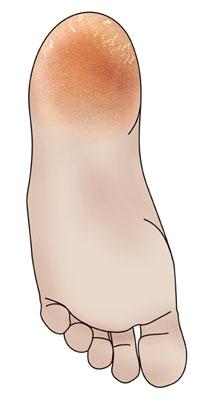Dry Skin on Feet and Cracked Heel Treatment, Symptoms, Prevention and Causes
The most common type of dry skin on the foot develops on the heels. Cracked and dry skin on heels are a common foot problem that is often referred to as heel fissures. Cracked heels are commonly caused by dry skin (xerosis), and made more complicated if the skin around the rim of the heel is thick (callus).
For most people this is a nuisance and a cosmetic problem but when the fissures or cracks are deep, they are painful to stand on and the skin can bleed - in severe cases this can become infected.

Symptoms
What are dry cracked skin on feet symptoms?
If the cracks are bad enough there will be pain on weight bearing that is not there when weight is off the heel. The edges or rim around the heel will generally have a thicker area of skin (callus). Wearing open or thin soled shoes usually make the symptoms worse.
Causes
What causes dry cracked skin on feet?
Some people tend to have a naturally dry skin that predisposes them to the cracks. The thickened dry skin (callus) around the heel that is more likely to crack is often due to mechanical factors that increase pressures in that area (eg the way you walk). Other factors that can be involved in the cause of dry cracked heels include:
- Prolonged standing being overweight
- Open back on the shoes
- Skin conditions (eg psoriasis and eczema)
Prevention
How to prevent cracked heels?
Calluses can usually be prevented by avoiding friction-causing activities and wearing shoes that fit properly, are activity-appropriate, and are kept in good repair. Soles and heels that wear unevenly may indicate a need for corrective footwear or special insoles. Socks and stockings should not cramp the toes. Women should also steer away from wearing high-heeled shoes.
Wear comfortable shoes. Ill-fitting footwear often causes corns and calluses. Wear shoes that do not cramp your toes.
Look at the heels on an old pair of shoes. If one side is markedly worn, you may be shifting your weight unevenly as you walk.
Ask your physician or podiatrist if a shoe insert (orthotic) could help distribute your weight more evenly. Protect your skin. Visit your pharmacy or medical supply store.
Treatment
What is the best treatment for dry cracked feet and heels?
- Moisturizing feet regularly.
- Avoid going barefoot or wearing open-backed shoes, sandals or shoes with thin soles.
Links to recommended PediFix® Products:





